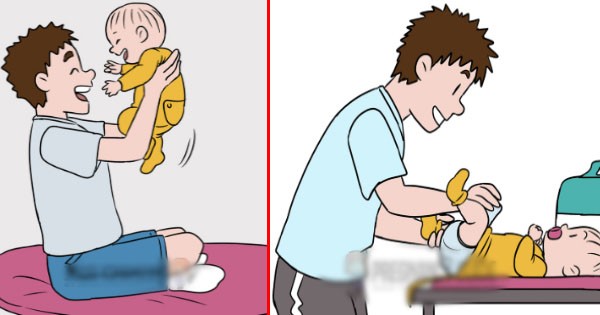

Growth spurts in babies can happen overnight. Although it is a happy and good sign, this period can also be nerve-wracking for the babies and their parents. During this time, the baby might feel uncomfortable and frequently cry, which makes them fussy and cranky. So how do you handle these growth spurts?
Read on to know about growth spurts, when they happen, and how to manage your baby while they are undergoing a growth spurt.
What Is Growth Spurt In Babies?
Growth spurt in babies is a considerable increase in their physical development such as the weight, height, and circumference of the head. The baby may achieve a developmental milestone during this phase as several layers of new cells add on in the body in a short duration.
When Do Babies Go Through Growth Spurts?
According to the American Academy of Pediatrics, growth spurts can occur at different ages (1). However, the specific ages are (2):
- First growth spurt: Two weeks
- Second growth spurt: Three weeks
- Third growth spurt: Six weeks
- Fourth growth spurt: Three months
- Fifth growth spurt: Six months
In some babies, growth spurt can happen at a stage different from the above, and it may be faster or slower.
Therefore, look out for signs so that you can recognize your baby’s growth spurt.

What Are The Signs Of A Baby’s Growth Spurt?
Prominent life events occur when the baby is going through a growth spurt:
1. Rapid gain in height, weight, and head circumference:
- Average height and weight growth (males and females):
| GROWTH SPURT | HEIGHT GAIN | WEIGHT GAIN |
|---|---|---|
| First, Second, Third, Fourth | 2.5 – 3.8cm | 907g |
| Fifth | 1 – 2cm | 450 – 560g |
- Average head circumference growth:
| GROWTH SPURT | MALE HEAD CIRCUMFERENCE GAIN (3) | FEMALE HEAD CIRCUMFERENCE GAIN (4) |
|---|---|---|
| First, Second | 2.8cm | 2.6cm |
| Third | 1.8cm | 1.8cm |
| Fourth | 1.4cm | 1.2cm |
| Fifth | 0.7cm | 0.7cm |
The baby would gain more height and weight at the end of the sixth month (fifth growth spurt) than earlier and weighs double the birth weight(5).
Girls have more advanced skeletal maturation, but lower percentage increase in height than boys (6). The growth speed equalizes between both the genders after seven months.
2. Increase in hunger:
- There is an increase in the baby’s appetite to meet the nutritional requirement of their body. This is referred to as feeding spurts.
- Babies will demand extra food in their sixth month.
- Babies who are still breastfeeding require feeds almost every waking hour.
3. Changes in sleep pattern:
- Babies tend to sleep more during growth spurts. Research shows that sleep stimulates the production of human growth hormone, which facilitates the formation of additional body cells and thereby new tissue layers (7).
- During a growth spurt, a baby can sleep four-and-a-half hours extra (on an average) every day (8).
- The total sleeping hours will depend on what stage the infant is in. For example, an average three-month-old will sleep 14 hours a day (9), but during spurts of growth, he may sleep for 18.5 hours.
4. Behavioral changes:
- Babies are usually fussy and clingy and may also throw tantrums frequently.
- In many cases, fussiness could be the result of excessive hunger. When provided with food and comfort, the baby’s irritation may subside.
- The causes of change in the baby’s behavior during the growth spurt are unknown. Some experts associate the cranky behavior to the temporary surge in the growth hormone of the body (10).
As growth spurt will last two to three days, you need to know how to deal with the situation (11).
How To Manage A Baby’s Growth Spurt?
Growth spurt in babies can be perplexing and tiring for a mother, but you can handle it by being prepared.
1. Feed the baby frequently:
- Feeding at regular intervals to support the growth is called cluster feeding. Cluster feeding during growth spurt can be exhausting for the mother but the baby comes back to their regular nursing schedule after two to three days.
- If the baby is formula-fed, then prepare a larger batch of formula milk.
- If the infant is older than six months and fed on semi-solid food, then increase the number of meals he has in a day to meet his hunger demands.
2. Facilitate comfortable sleep for the baby:
- A baby needs more sleep during growth spurts, which is why it is imperative to have a peaceful and undisturbed sleeping environment.
- Newborns sleep for an equal number of hours during the day and night. However, from the third month, babies begin sleeping longer during the night (12).
3. Managing the baby’s behavior:
- Stay calm when the baby is excessively fussy. Try feeding them, playing with their favorite toy, or doing something else to calm them. Cuddle with the baby for skin-to-skin contact.
- Older infants tend to throw tantrums but understand basic commands and instructions. If the baby is cranky, show their favorite toy or food, and check if it helps them calm down.
Growth spurts can be tense moments for the parents but do not cause any problem to the baby, and some infants undergo a growth spurt without showing any visible signs. There is no need to fret about your little one in any case. However, there are some signs you must be watchful about during the days of a growth spurt.
When To Be Concerned?
If your baby is showing these signs, then take him to a doctor for an expert opinion:
- Eats less and sleeps a lot: If baby is eating less and sleeping excessively, then it could be an indication of an underlying problem. Infants below 11 months must not sleep beyond 18 hours.
- Stays fussy mostly: If the baby is never happy no matter what you do, and has constant mood swings even after the three days of growth spurt, then you must consult a doctor.
Frequently Asked Questions
1. How long does a growth spurt last in babies?
Growth spurts last for a few days in babies. As they grow, the growth spurt may even last for weeks. Typically, growth spurts don’t last longer than a week.
2. Should I let my baby sleep during a growth spurt?
Babies sleep a lot during growth spurts. Waking a baby for feeding during the initial few weeks to ensure optimal feeding is necessary. However, once the baby grows and gains optimum weight, you can let them sleep longer between feedings. Speak to your pediatrician if you are unsure about waking up your baby for feeding during growth spurts.
Growth spurts occur in all babies, and the behavioral changes make it evident for the parents to know when they occur. It can be difficult for parents when the baby is going through a growth spurt as the babies may be more cranky during the phase. Their sleeping and eating patterns also change broadly. While there is a basic guideline about the expected time of growth spurts, each baby reaches these milestones at their pace. A little more cuddling, skin-to-skin, more attention, and increased feeding hours will help you wade through the spurt. If there are no visible signs of growth, you should see your baby’s doctor.

















































